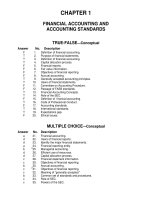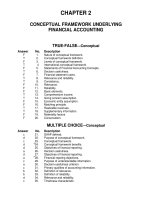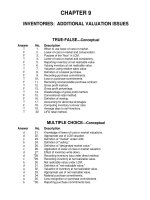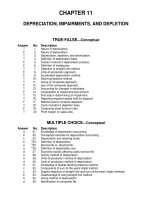Intermediate accounting 16e by kieso slide ch18
Bạn đang xem bản rút gọn của tài liệu. Xem và tải ngay bản đầy đủ của tài liệu tại đây (2.94 MB, 141 trang )
18-1
PREVIEW OF CHAPTER 18
Intermediate Accounting
16th Edition
Kieso ● Weygandt ● Warfield
18-2
18
Revenue Recognition
LEARNING OBJECTIVES
After studying this chapter, you should be able to:
18-3
1 Understand the fundamental
concepts related to revenue
recognition and measurement.
3 Apply the five-step process to
major revenue recognition
issues.
2 Understand and apply the fivestep revenue recognition
process.
4 Describe presentation and
disclosure regarding revenue.
LO 1
FUNDAMENTALS OF REVENUE
RECOGNITION
Recently, the FASB and IASB issued a converged standard
on revenue recognition entitled Revenue from Contracts
with Customers.
To address the inconsistencies and weaknesses of the
previous approaches, a comprehensive revenue recognition
standard now applies to a wide
range of transactions and
industries.
18-4
LO 1
New Revenue Recognition Standard
Revenue from Contracts with Customers adopts an
asset-liability approach. Companies:
18-5
Account for revenue based on the asset or liability arising
from contracts with customers.
Are required to analyze contracts with customers
Contracts indicate terms and measurement of
consideration.
Without contracts, companies cannot know whether
promises will be met.
LO 1
New Revenue Recognition Standard
ILLUSTRATION 18-1 Key Concepts of Revenue Recognition
18-6
Performance Obligation is Satisfied
LO 1
The Five-Step Process—Boeing Example
Assume that Boeing Corporation signs a contract to sell airplanes to
Delta Air Lines for $100 million.
ILLUSTRATION 18-2
Five Steps of Revenue Recognition
Step 1: Identify the
contract
with customers.
A contract is an agreement between two parties
that creates enforceable rights or obligations. In
this case, Boeing has signed a contract to deliver
airplanes to Delta.
Step 2: Identify the
separate performance
obligations in the
contract.
Boeing has only one performance obligation—to
deliver airplanes to Delta. If Boeing also agreed to
maintain the planes, a separate performance
obligation is recorded for this promise.
18-7
LO 1
The Five-Step Process
ILLUSTRATION 18-2 Five Steps of Revenue Recognition
Step 3: Determine
the transaction
price.
Transaction price is the amount of consideration
that a company expects to receive from a
customer in exchange for transferring a good or
service. In this case, the transaction price is
straightforward—it is $100 million.
Step 4: Allocate the
transaction price to
the separate
performance
obligations.
In this case, Boeing has only one performance
obligation—to deliver airplanes to Delta.
18-8
LO 1
The Five-Step Process
ILLUSTRATION 18-2 Five Steps of Revenue Recognition
Step 5: Recognize
revenue when
each performance
obligation
is satisfied.
18-9
Boeing recognizes revenue of $100 million for the
sale of the airplanes to Delta when it satisfies its
performance obligation—the delivery of the
airplanes to Delta.
LO 1
18
Revenue Recognition
LEARNING OBJECTIVES
After studying this chapter, you should be able to:
18-10
1 Understand the fundamental
concepts related to revenue
recognition and measurement.
3 Apply the five-step process to
major revenue recognition
issues.
2 Understand and apply the fivestep revenue recognition
process.
4 Describe presentation and
disclosure regarding revenue.
LO 2
Identifying Contract with Customers—
Step 1
Contract:
18-11
Agreement between two or more parties that creates
enforceable rights or obligations.
Can be
written,
oral, or
implied from customary business practice.
LO 2
Identifying Contract with Customers—
Step 1
Company applies the revenue guidance to a contract
according to the following criteria:
1. The contract has commercial substance.
2. The parties have approved the contract
3. Identification of the rights of the parties is established
4. Payment terms are identified
5. It is probable that the consideration will be collected.
18-12
LO 2
Identifying Contract—Step 1
ILLUSTRATION 18-3
Basic Revenue Transaction
CONTRACTS AND RECOGNITION
Facts: On March 1, 2017, Margo Company enters into a contract to transfer a
product to Soon Yoon on July 31, 2017. The contract is structured such that
Soon Yoon is required to pay the full contract price of $5,000 on August 31,
2017.The cost of the goods transferred is $3,000. Margo delivers the product to
Soon Yoon on July 31, 2017.
Question: What journal entries should Margo Company make in regards to
this contract in 2017?
The journal entry to record the sale and related cost of goods sold is as follows.
July 31, 2017
Accounts Receivable
Sales Revenue
5,000
5,000
Cost of Goods Sold 3,000
Inventory
18-13
3,000
LO 2
Identifying Contract—Step 1
ILLUSTRATION 18-3
Basic Revenue Transaction
CONTRACTS AND RECOGNITION
Facts: On March 1, 2017, Margo Company enters into a contract to transfer a
product to Soon Yoon on July 31, 2017. The contract is structured such that
Soon Yoon is required to pay the full contract price of $5,000 on August 31,
2017.The cost of the goods transferred is $3,000. Margo delivers the product to
Soon Yoon on July 31, 2017.
Question: What journal entries should Margo Company make in regards to
this contract in 2017?
Margo makes the following entry to record the receipt of cash on August 31, 2017.
August 31, 2017
Cash
5,000
Accounts Receivable
18-14
5,000
LO 2
Separate Performance Obligations—Step
2
A performance obligation is a promise to provide a distinct
product or service to a customer.
A product or service is distinct when a customer is able to
benefit from a good or service on its own or
together with other readily available resources.
The objective is to determine whether the nature of a
company’s promise is to transfer individual goods and services
to the customer or to transfer a combined item (or items) for
which individual goods or services are inputs.
18-15
LO 2
Separate Performance Obligations—Step
2
ILLUSTRATION
Assume that General Motors sells an automobile to Marquart Auto
Dealers at a price that includes six months of telematics services such
as navigation and remote diagnostics. These telematics services are
regularly sold on a standalone basis by General Motors for a monthly
fee. After the six-month period, the consumer can renew these services
on a fee basis with General Motors. The question is whether General
Motors sold one or two products.
If we look at General Motors’ objective, it appears that it is to sell two
goods, the automobile and the telematic services. Both are distinct
(they can be sold separately) and are not interdependent.
18-16
LO 2
Separate Performance Obligations—Step
2
ILLUSTRATION
SoftTech Inc. licenses customer-relationship software to Lopez
Company. In addition to providing the software itself, SoftTech promises
to provide consulting services by extensively customizing the software to
Lopez’s information technology environment, for a total consideration of
$600,000. In this case, SoftTech is providing a significant service by
integrating the goods and services (the license and the consulting
service) into one combined item for which Lopez has contracted. In
addition, the software is significantly customized by SoftTech in
accordance with specifications negotiated by Lopez. Do these facts
describe a single or separate performance obligation?
The license and the consulting services are distinct but interdependent,
and therefore should be accounted for as one performance obligation.
18-17
LO 2
Determining the Transaction Price—Step
3
Transaction price
18-18
Amount of consideration that company expects to
receive from a customer.
In a contract is often easily determined because
customer agrees to pay a fixed amount.
Other contracts, companies must consider:
Variable consideration
Time value of money
Noncash consideration
Consideration paid or payable to the customer
LO 2
Determining the Transaction Price—Step
3
Variable Consideration
Price dependent on future events.
18-19
Might include discounts, rebates, credits, performance
bonuses, or royalties.
Companies estimate amount of revenue to recognize.
Expected value
Most likely amount
LO 2
Determining the Transaction Price—Step
3
ILLUSTRATION 18-4 Estimating Variable Consideration
Expected Value: Probability-weighted amount in a range of possible
consideration amounts.
May be appropriate if a company has a large number of contracts with
similar characteristics.
Can be based on a limited number of discrete outcomes and probabilities.
Most Likely Amount: The single most likely amount in a range of possible
consideration outcomes.
May be appropriate if the contract has only two possible outcomes.
18-20
LO 2
Variable Consideration
ILLUSTRATION 18-5
Transaction Price
ESTIMATING VARIABLE CONSIDERATION
Facts: Peabody Construction Company enters into a contract with a
customer to build a warehouse for $100,000, with a performance bonus of
$50,000 that will be paid based on the timing of completion. The amount of
the performance bonus decreases by 10% per week for every week beyond
the agreed-upon completion date. The contract requirements are similar to
contracts that Peabody has performed previously, and management believes
that such experience is predictive for this contract. Management estimates
that there is a 60% probability that the contract will be completed by the
agreed-upon completion date, a 30% probability that it will be completed 1
week late, and only a 10% probability that it will be completed 2 weeks late.
Question: How should Peabody account for this revenue arrangement?
18-21
LO 2
Variable Consideration
ILLUSTRATION 18-5
Transaction Price
Question: How should Peabody account for this revenue arrangement?
Management has concluded that the probability-weighted method is the
most predictive approach:
60% chance of $150,000 =
30% chance of $145,000 =
10% chance of $140,000 =
$ 90,000
43,500
14,000
$147,500
Most likely outcome, if management believes they will meet the
deadline and receive the $50,000 bonus, the total transaction price
would be?
$150,000 (the outcome with 60% probability)
18-22
LO 2
Variable Consideration
Only allocate variable consideration if it is reasonably
assured that it will be entitled to the amount.
Companies only recognizes variable consideration if
1. they have experience with similar contracts and are
able to estimate the cumulative amount of revenue,
and
2. based on experience, they do not expect a significant
reversal of revenue previously recognized.
If these criteria are not met, revenue recognition is
constrained.
18-23
LO 2
Determining the Transaction Price—Step
3
Time Value of Money
18-24
When contract (sales transaction) involves a significant
financing component.
Interest accrued on consideration to be paid over
time.
Fair value determined either by measuring the
consideration received or by discounting the payment
using an imputed interest rate.
Company reports as interest expense or interest
revenue.
LO 2
Time Value of Money
ILLUSTRATION 18-7
Transaction Price
-Extended Payment Terms
EXTENDED PAYMENT TERMS
Facts: On July 1, 2017, SEK Company sold goods to Grant Company for
$900,000 in exchange for a 4-year, zero-interest-bearing note with a face amount
of $1,416,163. The goods have an inventory cost on SEK’s books of $590,000.
Questions: (a) How much revenue should SEK Company record on July 1,
2017? (b) How much revenue should it report related to this transaction on
December 31, 2017?
Entry to record SEK’s sale to Grant Company on July 1, 2017, is as follows.
Notes Receivable
Sales Revenue
1,416,163
900,000
Discount on Notes Receivable
516,163
Cost of Goods Sold 590,000
Inventory
18-25
590,000
LO 2









